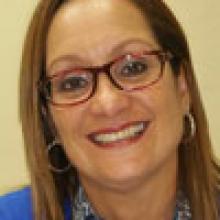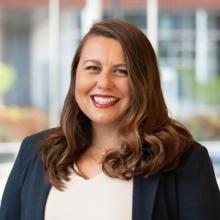Hispanic Heritage Month: Elevating Voices in the Field

To mark Hispanic Heritage Month, this episode of the International Educator Podcast is a conversation with Lysette Davi at University of Arizona and Frances Santiago of University of Puerto Rico-Mayagüez. They share their career journeys in international education, perspectives on diversifying the profession, challenges and successes in serving the Hispanic student population on their campuses, what international educators on all campuses can do to better serve these students, and more.
Lysette Davi is the Assistant Director of the Honors Global Experience at the University of Arizona, a Hispanic-Serving Institution (HSI), where she develops global pathways to build students cultural humility. She also works on bi-national border experiences, given her university’s location. Lysette has previously been awarded Tucson’s 40 Under 40 for her community-based work. She’s also currently in the NASFA Academy.
Frances Santiago is a professor of French language and Francophone Caribbean literatures and culture at the University of Puerto Rico-Mayagüez. She has been working in international student and scholar services since 2014, and she’s currently the PDSO and ARO for her campus. In September 2021, she was appointed director of institutional rankings and global alliances at the vice-presidency of academic affairs and research of the University of Puerto Rico. Since 2017, she’s been the Puerto Rico State Rep on NAFSA's Region 7 Leadership Team, though she’s stepping down in November.
Editor's note: This interview has been edited and condensed.
Can you tell us a bit about your own story and how you came to a career in international education?
Frances: I am from Puerto Rico, so my native language is Spanish. I studied at the University of Puerto Rico’s Río Piedras campus, and I majored in French. Then I went to Syracuse University, and I did a masters in French. And then I went to City University of New York, and I got a PhD in French. I went all the way! I think that is what, very early on, opened me up to new perspectives. Learning this third language was not only speaking and communicating, but it was also looking at the world differently. This is what I tell my students today. Speaking French is not only “Je m’appelle Frances.” It’s how people speak, why do they speak that way, how people think. That is what eventually led me to the realm of international education.
In 2013, I was asked to evaluate and make recommendations regarding international students and scholar services at the University of Puerto Rico’s Mayagüez campus, where I am a professor of French. My recommendation was that our campus needed an office because the services were spread among many offices. So, they said, “Great, you can be in charge of that.”
I became PDSO and eventually I became ARO. Immediately, one of my greatest collaborators and mentors from University of Puerto Rico’s Río Piedras campus in San Juan told me was you need to get into NAFSA if you want to learn. That is how I come into international education, and that is how I come into NAFSA. I'm fortunate enough that my campus supports my membership. In 2016, I became the Puerto Rico state rep for Region VII, and I'm stepping off in November.
Lysette: It’s interesting how I came to this field, and probably typical of a lot of people in the field, which is that they had the opportunity to study abroad. I am a first-generation Latina. I went to a mostly a white undergraduate space, and I was afraid to go abroad. My family had [taken] a few international trips as individuals, not as a family, and they were afraid to have me go. It also meant taking the summer off work. It meant spending time away from family, which is sacred.
I had the wonderful opportunity to do an internship, because my parents were most comfortable with [me] working abroad versus traveling or studying abroad. I worked in Parliament in London, and I also had the opportunity to travel to various other countries. I feel like Europe was a very easy introduction into international thinking. I had already studied international politics, and so it was an amazing experience to see what you learn in the classroom, and then to apply it.
I had always wanted to do the Peace Corps, and after school I spent some time thinking about that. My parents again were a little bit uncomfortable with me wanting to have another international experience. So, I moved closer to home to be with them for a year before doing Peace Corps.
I did the Peace Corps in the Philippines. I was an English teacher. I built amazing relationships [with people] I'm still in contact with today, for example, with my host sister. It's her birthday today! The relationship building, how authentic that was, and how it changed me and my perspectives was so valuable. I had taken the LSAT and decided to go to law school. But after the experience [in the Philippines] I thought that international education must be the most valuable thing in the world, and everyone has to do that.
I changed my life plan, and I went to school to study international higher education. I finished my PhD in 2020 studying cultural humility and how cross-cultural education plays a role in how we understand other cultures. And now I work in the international office at the University of Arizona, which happens to be an HSI (Hispanic-Serving Institution).
Thank you both for giving us that background. There is a lot of discussion in the field about diversifying not only in the student population that participates in international programs, but also the profession of international education itself. What have your experiences has been like pursuing your career in this field?
Frances: It has evolved. I started off working in this office where I am today, working with international students and scholars. Early on, I understood that I need a DSO, someone to work directly with the students because I'm a faculty member as well so my time is shared. In the very beginning, I was very overwhelmed with petitioning an H1-B for a newly hired scholar, working with all the regulations that have to do with international students, all the things that they have to be aware of and that we have to be aware of. Through NAFSA, especially the regional conferences, I took all the workshops that I could take. I grew within the field, and my perspectives changed from seeing it as something that was a little bit scary and almost too technical to something that I understood and that I could help others understand.
My evolution within this role as coordinator of international student and scholar services is that I have involved the rest of my campus: department chairs, our deans, our dean of students, chancellors, academic senators. I was also an academic senator when I started working on this, so I’m making sure that our university community, anyone that has anything to do with international students, that they understand these things.
I have involved the rest of my campus... I’m making sure that our university community, anyone that has anything to do with international students, that they understand these things.
In terms of diversifying, we need more people to get involved. Something that I learned early on as a graduate student is that there is always room for everyone and anyone who truly has a calling. Some of the challenges, especially in the very beginning, were changing certain people's perceptions about international students. Why are they here? What are they doing here? I call them pockets of resistance. We need to debunk all these myths about international. We have to see this as an enriching experience for the institution—and not just the institution, because international students come in and they live in our neighborhoods, they are part of society. In the context of Puerto Rico, it is so important that we have different people, that we see different people, that we hear Spanish but in different accents, that we hear people speaking other languages. For me, I think that we need more people involved in the field with all different kinds of backgrounds.
Lysette: I do think that race is something that's important to consider. It's true that mostly white women study abroad, and it's also true that most international offices are full of white women. It's because they, just like me, had this amazing experience abroad and want other people to have that same experience. So, I don't think we're going to see changes into the office, or who is representing internationalization, until we see it with our students. It's going to take a lot of time to transition and make more space for people of color in spaces.
I don't think we're going to see changes into the office, or who is representing internationalization, until we see it with our students. It's going to take a lot of time to transition and make more space for people of color in spaces.
But what I can say about my journey is that it was not linear; I had to pave my own way. I had my international research interest and sort of invited myself into spaces: “Look what I know, this is my research. There's this thing called cultural humility. It's really important.” And enough of those small conversations built relationships, and my role is really based on the relationship-building and helping people see that HSI efforts, especially where I'm located, is important to the future of study abroad and to the population that we work with as an HSI.
Is there anything that you wish that you had known before you pursued a career in international education?
Lysette: The pay structure is something that I'm really mindful of as a first-generation student. My parents thought that education is the pathway to a great life, and especially after finishing a PhD, it would seem like you were really set financially. But the field has been very challenging, and there are plenty of studies that show that race has a lot to do with that. I think that I have a lot more to prove—I have to prove myself over and over and over again. It is definitely something that I struggle with sometimes, but I wish I had known before I went into the field the reality of how much time it would take to be successful.
I have many mentors and people who I am in awe of, and I hope to be that to someone else one day. But it took a lot of time for them to get to those spaces, too, and so I wish I’d know that it was going to be a long journey.
I have a basic question about terminology. Between Hispanic, Latino, Latina, Latinx, there are many terms in use. What is your perspective on that, and how do you identify?
Lysette: That is such a great question, because it shows sometimes how academia is out of reach with common citizens. If you ask the average Hispanic family, they will not understand what that term Latinx means. When working with parents or working with students who are in their first, second, or third year of their international experiences, I will use the term Hispanic, because that's the term they're going to be the most familiar with.
However, as students start to understand their own identity, maybe they start taking classes and learn more about colonialism. They start to think of themselves more as Latino or Latina, and then to take it a step further, to be more inclusive, they make an x, so that we can consider all genders or binary folks. Typically, if it's just me, representing myself in a personal space, I would prefer what Latina. If I'm in an academic space with students or our families, it's Hispanic because we're an HSI. All the grants, all the federal funding will all use the term Hispanic. It is really fluid, and it's okay to use any of them.
Thank you for that context and background. Going back to diversifying the profession of international education, how can we ensure that there are Hispanic voices and representation in the field?
Frances: Well, this is an example. I think NAFSA has a good representation of Hispanic and Latinos, but we do need more. We do need more in Puerto Rico. I could say, it’s easy for us from Puerto Rico, because we are all Spanish speaking, or most of us, and all our institutions are serving our local students who are Hispanic. But we do need to have more people within the continental United States who are inspired or called to serve these students. The example that we give our students can also make them become practitioners. For example, I've been invited to be an outside reader for a doctoral dissertation for an international student from the Dominican Republic. She’s working on the good and the bad, the beautiful and the ugly, of institutional rankings. She is a young graduate student who could eventually become, and I think that who would be an excellent, practitioner. We need to encourage the youth that is rising.
We do need to have more people within the continental United States who are inspired or called to serve these students.
Lysette: I primarily work in a study abroad space, and I have a trip that just finalized its first round of participants. We have a professor who is a professor of color, and out of the fifteen students on the trip, thirteen are students of color. I have another trip—same trip, same timeline, similar countries—and it’s a white woman who is leading the trip. Fifteen of fifteen students on that trip are white. While I can't say that that sample size is indicative of an entire field, it does tell me is that having a faculty of color, whether it be in the classroom talking about international experiences, leading study abroad experiences, or just physically being in international offices, is going to change the field, because people see themselves. There was no special messaging that went out that said, “If you go on this trip, you're with a faculty of color.” But the faculty member’s picture was on the website. What type of difference does that make when people can see themselves in those spaces?
Taking it from an employer point of view, if you put post a job, applicants want to look at the website and see who their colleagues be. You can make a lot of judgments. Of course, people don't always look Hispanic or Latinx, so you can't make too many judgments on that. But you can get a feel for what type of environment that office might be like. Offices can make more effort toward diversifying their websites and diversifying how they plug in faculty and staff into their spaces.
We touched on the idea of the way to build a pipeline of diverse professionals in international education, or those who identify as Hispanic, is to diversify student participation in international opportunities. Can you tell us about what the participation is like at your institution among the Hispanic student population?
Lysette: It's one of the hardest things about identifying Hispanic students is that the way that census and university data works is that it can be a little bit confusing on how students identify. There's a section that asks, “Are you Hispanic or Latinx?” And then question will say, “Are you white?” Students get really confused on how to mark themselves, so our tracking is not very good in terms of how accurate we are in who we’re sending about.
But I know that it's a much lower number, and I think it’s because of a deficit approach on how we treat students of color, and specifically Latinx students. We have this idea that they're poor and that they can't afford to study abroad. Well, we have Gilman scholarships. We have Pell Grant options. We have scholarships. So, let's imagine ourselves without the financial barrier. What are the other barriers? Some of those things can be, for example, that study abroad programs are too long; the culture of our family is most important, and it's really hard to be away from them. It could be families not understanding the importance of international education. What type of communication are we giving to families? Is your university providing materials for the students to share with their loved ones to explain why this it’s important to them to have an international experience?
One way to widen participation is to think beyond the deficit approach of “they can't afford it; they don't want these experiences” and ask those basic questions.
One way to widen participation is to think beyond the deficit approach of “they can't afford it; they don't want these experiences” and instead ask those basic questions. They have a family behind them who wants them to have experiences, but they just need to understand it. What resources can make to help students have those experiences? Of course, expanding the options of locations would be great. If you look at Open Doors, and you see where we're sending students—if we keep it limited to the same destinations over and over, then why would the demographics of who has an international experience change? But we keep doing the same thing, and we're going to keep getting the same audience. It's important to think about Latin American countries and to build partnerships and to give students the options to have that international experience.
I'm working on an HSI initiative for Mexico. We live in Tucson, which is a border town. There is a lot of politics that exist here. There are a lot of students who really believe a wall should be there, and there are just as many students who feel like a wall shouldn't be there. It’s the beautiful job of education to allow those conversations and to help people critically reflect on what a border means, and to help them have the opportunity to see the border. So, I'm working on border programs, working with faculty, and trying to keep not only the price point accessible, but to find Spanish speakers to help lead the trips. Leaders who can talk to the families and who can make students feel more comfortable about spending their summer abroad.
Have there been any notable wins in recent years for your Hispanic students in the area of international education? Has there been anything that's encouraged you lately in serving these students?
Lysette: At the University of Arizona, I’m extremely proud of the efforts made by the HSI initiatives department. We have a beautiful, loud, respectful group with many, many ideas that come through, as well as a research group a grant-writing group that's always pursuing funding opportunities with that HSI designation. The office—which we are lucky to have; not every HSI has one—has created so many wins for the campus in terms of how students see themselves and the opportunities students know about, because they have access to information that they didn't have before. It also has changed the conversation across campus.
The HSI designation doesn't come with any federal funding; it allows you to apply for federal funding based on that destination. It’s a great opportunity for people who wouldn't normally collaborate on something like an HSI effort to collaborate on it and think, “Well, I've always wanted to do this project, and now I can apply for this funding, and we can make something happen.” So, regardless of if the funding is received, we're having those conversations, and I think that's one of the best parts.
The HSI designation doesn't come with any federal funding; it allows you to apply for federal funding based on that destination. It’s a great opportunity for people who wouldn't normally collaborate on something like an HSI effort to collaborate.
I was selected as an HSI Fellow, which is an opportunity at my university, and I got to work on a project on trans-border international collaborations and create a network of the faculty and staff from across campus who work on border programs. That led to another grant that I’m working on. It’s just beautiful to see what that designation has done for internationalization, because now we're thinking about Latin America, we're thinking about the Latinx community while having opportunities because of HSI designation. It’s a lot of wins.
Frances: A lot of our international students come to Puerto Rico from Latin America, so they are Spanish-speaking students, and they usually come as graduate students. One of the wins is when they decide to go on to doctoral degrees, because we encourage them to continue studying. Many of them decide to take that step in the continental United States, where the main language is English. Since they're Spanish-speaking students, it is so important for them to know that they have good preparation.
The human factor makes the difference with our students moving along. They can cultivate a perspective that makes them better people.
And in Puerto Rico, it’s about the dynamics of inclusion; that international students have been a part of making our university not only more diverse but accepting of other students. One of the main points for me, personally, is kindness. We need to be compassionate. We need to be kind to our international students, and that is something that they will take away with them and that they will put into practice as well. The human factor is so important. Of course, the academics are important, of course, following all of the SEVP and ICE rules and COVID guidance is important. But I think that the human factor makes the difference with our students moving along. They can cultivate a perspective that makes them better people and makes them practice inclusion and kindness in whatever field they go into.
What have some of the challenges been to expanding participation in international experiences among Hispanic students at your institutions? What have you learned that international educators on all campuses, HSIs or otherwise, can do to overcome these challenges?
Frances: We have a sort of a reverse challenge than in the continental United States, it is that we want to have more non-Hispanic or non-Spanish speaking students. We have our local students, we have students from Latin America, we have students from Central America and the Caribbean, but we would like to have more students from China. We would like to have more students from India. And sometimes the challenge is really in the language. Most classes in the STEM disciplines are taught in English, or have English textbooks, and for international collaborations the main language is English. But the teaching and everyday life is in Spanish.
Some professors do teach in English at the University of Puerto Rico, but it is a minority. We need to make sure that international students who are not Spanish speakers can come to University of Puerto Rico, they can thrive, they can complete their degrees. That is our challenge, which is, as I said, is a bit of a reverse challenge.
Lysette: I love that question so much because it's an invitation. There's this idea that maybe you shouldn't pursue this population of students because you don't identify with that population. But we need you. We need you to just want to be a part of the conversations. So really, this conversation, the HSI identity, and the growth of opportunities is an invitation to everyone to say, “you can do it, too, at your university,” even if your office has no Latinos because of where you're located. That's okay. But maybe your university has students who identify as that, and you can do so many things on your campus to have wins. Those wins can be diversifying where you send students abroad or the collaborations with universities that you have. It can be really simple. At my institution I started a book club, and we read about different cultures. Those tiny steps have helped all of us understand cultures that we wouldn't normally consider. Anytime you're willing to learn about another culture, or even say, “I don’t know. Is there anyone else I can ask who wants to help be a part of this?”—that’s a win.
We need you. We need you to just want to be a part of the conversations. ...You are the right person. If you're working in internationalization, you're the person who can help move this demographic forward in having international experiences.
It's a mindset. Sometimes people think working with Hispanic students is a lost cause in terms of financial gain, because they're not going abroad, or they're not participating in internationalization in the same capacity as other demographics. But if you look at their assets, you could change that, and it could create a financial model that's going to help your institution. It could be financially beneficial, while at the same time giving these students an opportunity that they wouldn't otherwise have. I encourage anyone who's listening to this, or who's working in the space: You are the right person. If you're working in internationalization, you're the person who can help move this demographic forward in having international experiences.
It’s important for many reasons that students have access to international education opportunities. What are some of the ways that you think these opportunities can specifically benefit Hispanic students?
Lysette: I think that when a student has an international experience in undergrad, it changes their life. I know that it changed mine, and I know that it changed my family's life beyond myself, because they became more open to international experiences. No matter who you are or where you're from, how you grow up has an impact on your mindset, and just learning about other cultures can help us think differently about the world around us. It can help up problem-solve, it can help us think about interdisciplinary issues in more concrete ways. Internationalization has so much power, and I don't want this group of students to not have that experience.
In a professional sense, my colleagues are so kind to me. I love all the people that I work with, and what I really appreciate with them is that they give me space to be heard. They ask, “What do you think about this?” Or you know they bring me into certain meetings to give perspectives. The opportunities are endless, and I hope that we see more and more people with this identity have those international experiences that they've mostly not had in the last decade or so.
Internationalization has so much power, and I don't want this group of students to not have that experience.
Frances: Last year, I was working at the vice presidency of academic affairs at the University of Puerto Rico central administration; I was a director of institutional rankings and global alliances. Within that work, I wrote what I hope becomes an institutional policy regarding DACA and undocumented students. We do have undocumented students in Puerto Rico, as it is a U.S. territory, and we also have DACA students. But beyond that, within the continental United States, there are so many DACA and undocumented students who face the challenge of travel. If this institutional policy is certified, then we would be opening access to higher education to these students. They could be locally present, or they could be students in the continental United States, and they would have access to a high-quality university. It would be a lesser tuition cost for DACA students to study at the University of Puerto Rico versus other institutions within the continental United States. This would highly impact Hispanic and Latinx students because we know that many of the DACA and undocumented students within the United States are of Hispanic and Latinx background. We need to have these policies in place. It’s an opportunity that we need to create.
We also have online programs that are already certified and accredited, and we need to open ourselves up to virtual exchanges. Covid was an awakening, in a way. We have this technology that is here for us. When we talk about exchange programs, we should identify courses for virtual exchange—so that a student can have three courses on campus at the University of Puerto Rico, one course at Spain or Mexico, Peru, Child, or India, because those could be virtual exchange courses. Early in the pandemic, when all the exchange coordinators and directors of exchange offices were saying, “What are we going to do now? We were used to sending our students away and receiving students; now what do we do?” We all worked with virtual exchanges at some point, and we should not let that be something we did just to get by during the pandemic. It is something that we need to work on and incorporate within our internationalization practices.
Lysette, you’re in a study abroad office. And we know that very often, student interest in study abroad has to do with hearing about their peers’ experience doing the same. What are some ways to amplify the voices of Hispanic students who have studied abroad in order to encourage others to participate?
Lysette: I don't have the best answer to this. I can just give some examples of what has been working, but I’m sure there's many people who have much better ideas. One of the strategies we've been using at the University of Arizona is Instagram takeovers. Students log into the university accounts and share their experiences while abroad. We're very cognizant of who we're selecting to do the takeover, and we're showing them that we’re really proud of them for having this experience. They’re excited to do the takeover and to share with their family and friends, as well as the rest of the institution, what they're doing.
We also ask students to create digital stories, and we have a file for those. So, when we’re talking with a student who is interested in study abroad, we've seen the other students’ digital stories and we know which one be a story that someone needs to hear. If the student is willing to share their story, we might use it with another student and say, “I think this might make you feel a little more comfortable. Do you want to watch this digital story?” Sometimes they want to watch it with us; sometimes they want to watch it on their own um. But hearing from students in that personal way has really made a difference. They think that they can do it, too, that they have these experiences. We don’t give the students a script or any rules, we just say in under five minutes, please share your study abroad experience and what you’d want other students to know. That has been a great tool to amplify voices by just sharing them with other students.
Campus internationalization goes beyond study abroad and can serve students who aren't able, or choose not, to participate in study abroad programs. How does campus internationalization inform the overall student experience, even for those who don't or can't pursue those opportunities?
Lysette: Just yesterday I was in one of the COIL classrooms, and for those who don't know, COIL is when two institutions have students interacting from both locations—it could be a synchronous or asynchronous course. And yesterday was the first day of the COIL program. It was so great the students introduce themselves to their peers in Mexico and to see how excited they were and what they shared about themselves and figuring out how to communicate. They were working together and problem solving in a 50-minute class that didn't cost any student anything additional. They already paid their tuition for their classes. It was definitely more work for the faculty, but students had an international experience without having to do anything but show up to class.
There are ways to be creative in how we give each other international experiences. It doesn't mean physically going somewhere. It's, who are you inviting to your classroom? Are there guest speakers coming? Are you encouraging students to take advantage of what's available locally? Is there a service learning with your local community that represents some of the other cultures that exist? We also have something called micro-campuses, and that is where students are abroad, but they take classes at the University of Arizona. So, they're also interacting in those spaces as well. As creative as you want to be, or as creative as your university allows you to be, there are ways to make international experiences extremely accessible.
As creative as you want to be, or as creative as your university allows you to be, there are ways to make international experiences extremely accessible.
Frances: We need to coordinate with our partner institutions, people that we already have exchange programs with, or people that we would like to have exchange programs with. This way we can figure out what courses can be offered to students from the University of Puerto Rico, and what courses that we can offer online benefit other students. That exchange would be beneficial for everyone involved because we would have our local students in a virtual classroom somewhere in the world. This would be beyond distance learning. Of course, there will always be challenges with different time zones, and other things that you have to tweak and figure out. But the great benefit would be that students would be in contact with other students that have the same or similar interests. Obviously, it is not the same as being in another country, but we know that there are students that cannot or will not go abroad but who are eager to have a different experience.
Going back to the human factor, the possibilities of exchanging with other professors, students, and people from other countries are for personal growth. Students are always thinking about if it’s counting toward their curriculum, so we need to make sure that these courses appear in the student's transcripts, that it is a valid course that they need to take, that it counts for credit. But beyond those details, I think that the experience is what is most important, and they will have the opportunity of talking to different people. •
About International Educator
International Educator is NAFSA’s flagship publication and has been published continually since 1990. As a record of the association and the field of international education, IE includes articles on a variety of topics, trends, and issues facing NAFSA members and their work.
From in-depth features to interviews with thought leaders and columns tailored to NAFSA’s knowledge communities, IE provides must-read context and analysis to those working around the globe to advance international education and exchange.
About NAFSA
NAFSA: Association of International Educators is the world's largest nonprofit association dedicated to international education and exchange. NAFSA serves the needs of more than 10,000 members and international educators worldwide at more than 3,500 institutions, in over 150 countries.
NAFSA membership provides you with unmatched access to best-in-class programs, critical updates, and resources to professionalize your practice. Members gain unrivaled opportunities to partner with experienced international education leaders.
















